Remember 1980? That was the year AC/DC released Back in Black, and the same year that Black Sabbath backfilled Ozzy with Ronnie James Dio (resulting in the incredible song “Heaven and Hell,” but not much else). It was a golden year for metal.
The same can’t be said for marketing. Sure, the 1980s gave us classic campaigns like Wendy’s “Where’s the Beef?” But marketers mostly had to pray their print or TV advertisements resonated with the right audiences.
Compare that today, when the Internet offers marketers increasingly deep insight into consumer behavior. With the combination of smartphones and “beacons“—short-range gizmos that track you through a store—comes the ability to reach those consumers with the right offer in the right place at the right time.
At least, that’s the sales pitch. Literally.
The reality of beacons, however, is that while the technology can largely deliver as advertised, most marketers still don’t know quite what to do with it.
Converging Physical And Digital Worlds
With this promise in mind, it’s not surprising to see more than half of the top 100 U.S. retailers rolling out beacon trials, as BI Intelligence details.
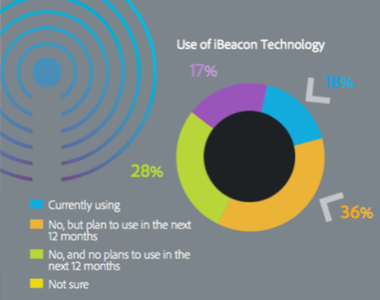
And given the early days of beacon technology, it’s even more impressive that 18% of those surveyed by Adobe (full disclosure: my employer) say they’ve rolled out beacons.
Organizations as diverse as GameStop, the U.S. Open, and Hillshire Brands report successful beacon deployments. (Conversely, Nordstrom and others have canned theirs due to privacy or other concerns.)
Still, that interest is nowhere near translating into the massive, near-term adoption that BI Intelligence projects.
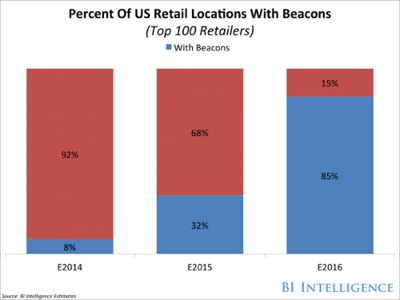
Today, companies are still toe-dipping on beacons. Try finding an active, effective beacon deployment at your local mall, bank, or even your local Apple Store.
It’s hard.
In fact, if you ask marketers about their priorities, location technology is pretty far down the list, with more basic blocking and tackling (analytics, A/B testing, etc.) claiming more interest:
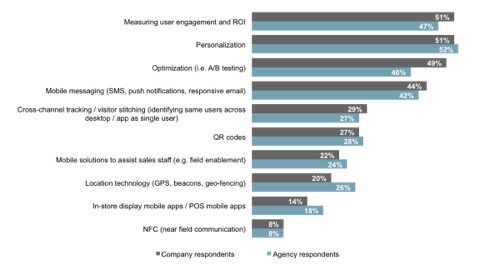
This isn’t because marketers don’t care about putting GPS, beacons, and geo-fencing to work. And it isn’t because beacons and location technology won’t be big.
Rather, it’s because enterprises still struggle to know how to deploy them effectively.
Teach Me To Fish
Think about your favorite retailer, bank, or any other business or location that you regularly visit. Imagine that store manager, event organizer, or sales associate masterminding a complex digital strategy. No, they’re not stupid. This just hasn’t been part of their job description.
At a Nordstrom, a sophisticated team manages the Web presence. At your local Nordstrom store, there is simply no equivalent.
The technology exists to segment users who enter a store. To track their foot traffic as they walk through the store. To present them with offers (assuming they have the vendor’s app) keyed to past purchasing history, dwell time in certain departments, and more.
But that campaign to nudge a user to visit a bathroom renovation seminar at the local Ace Hardware still needs to be conceived, planned, and implemented by someone, and most physical locations simply don’t have someone charged with digital. Also the cost of deploying beacons—even given plummeting hardware prices—is non-trivial. Lastly, as one head of mobile at a large U.S. retailer told me, they’re simply not set up to orchestrate physical interaction based on digital data.
Not yet.
So part of what we need to truly blend the physical and digital worlds is for enterprises that depend on physical locations to stop thinking of themselves as such, and instead to staff up to go digital, even “offline.”
Taking Mobile Seriously
But first, not surprisingly, enterprises need to get serious about mobile. Oh, sure, everyone knows mobile is big, and companies tend to acknowledge this in surveys.
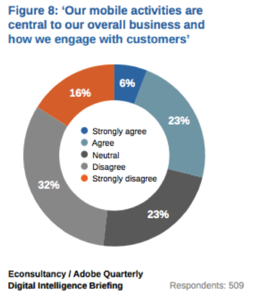
But what this data actually shows is that we still have a ways to go. After all, with Ericsson projecting 90% of the world’s population over the age of 6 to own a phone by 2020, mobile can’t simply be another screen to which companies cater. It has to be the screen.
While not every business is necessarily a mobile business (a company that builds windmills, for example, probably doesn’t need an app), it’s hard to imagine many consumer-facing businesses that can get away without deep and abiding investments in mobile.
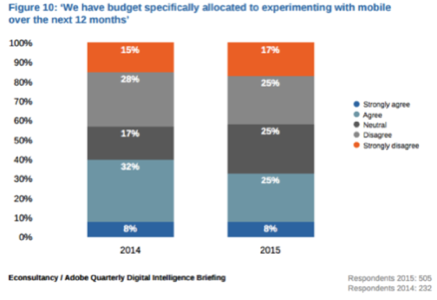
Which is why it’s not enough to talk about mobile. You also need to fund it.
While the Adobe survey cited above found significant pockets of mobile investment—30% of those surveyed reported a minimum of $5 million spent annually on mobile apps and websites and an average annual investment of $5.5 million on mobile apps and $4.9M on mobile websites—the chart above suggests we have a long way to go.
And until we get there—until mobile becomes core to a company’s DNA—it’s hard to imagine the kinds of dramatic investments in beacons that BI Intelligence projects. Location is critical to mobile, but not until companies first get their mobile acts together.
This article roughly follows the presentation the author gave at M1 Summit in New York City in May 2015.
Lead photo by Intel Free Press









